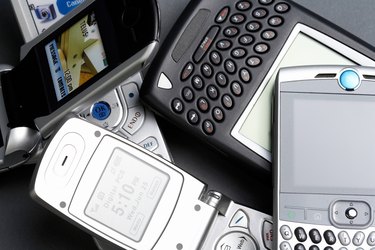
Whether you're talking about cellphones or microwaves or radios, they all have at least one thing in common: they receive or transmit signals. The kind of wavelength and the frequency determine the effect of the transmission. Cellular telephones work because they transmit and receive in a clearly defined range of frequencies. The 800- to 2400-megahertz transmission waves from a cellphone have a wavelength of approximately one foot and fall on the RF part of the electromagnetic spectrum.
Waves
Video of the Day
Just like visible light waves, radiofrequency waves radiate at different speeds and with different wavelengths. A wavelength is the distance covered by one complete wave. Waves with a high frequency possess less energy than waves with a low frequency. Think of it this way; if you're watching waves crash on the beach, more energy is coming ashore when waves come more frequently. When the water is calm, the waves crash less frequently, transferring less energy.
Video of the Day
Electromagnetic Spectrum
There are many kinds of electromagnetic waves; these are differentiated by their wavelength and frequency. AM and FM radio, broadcast television, GPS units and cordless phones are all examples of devices that transmit and receive these waves. These devices are calibrated to communicate using a specific range of the spectrum. For example, baby monitors use the 49 megahertz frequency. The different parts of the spectrum have been split by government authorities and scientists to prevent interference and allow for industry standards.
Electromagnetic Waves
Cellphones receive and transmit electromagnetic waves. These waves fall between 800 and 2400 megahertz. The wavelengths are approximately a foot in length. These kinds of waves are far larger than the wavelengths of the kind of light that can be perceived by human eyes. The wavelength of visible light is approximately .00004 centimeters.
Changing Standards
Cellphone technology keeps evolving. As it does so, slightly different wavelengths are being made the standard. According to "Electronic Design," a magazine and accompanying website that chronicles the changes in emerging technologies, future-generation phones will use slightly different electromagnetic frequencies to communicate. The new frequencies to be used also affect the size of a cellphone's necessary antenna, shaping the physical dimensions and design of future cellphones.
- Department of Education Office of Science: Blocking Radio Waves; Bob Wilson
- Space Today: What is the Electromagnetic Spectrum?
- SUNY Oneonta: Chemistry 111; Chapter 6: Electromagnetic Radiation; Bill Vining; Fall 2010
- The Center for Science Education at the UC Berkeley Space Sciences Laboratory: Light Wavelength Size
- "Electronic Design": Wireless Companies Follow The Roadmap Past 4G And On to 5G; Louis E. Frenzel; June 2011
- National Aeronautics and Space Administration: Radio Waves